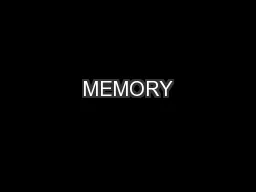

Atkinson and Shiffrins 1968 multistore model of memory Multistore model of memory The memory model that visualises memory as a system consisting of multiple memory store through which a stream of data flows for processing ID: 384888
Download Presentation The PPT/PDF document "MEMORY" is the property of its rightful owner. Permission is granted to download and print the materials on this web site for personal, non-commercial use only, and to display it on your personal computer provided you do not modify the materials and that you retain all copyright notices contained in the materials. By downloading content from our website, you accept the terms of this agreement.
Slide1
MEMORY
Atkinson and Shiffrin’s (1968) multi-store model of memorySlide2
Multi-store model of memory
The memory model that visualises memory as a system consisting of multiple memory store through which a stream of data flows for processing.
For information to be stored, it must pass through three memory stores:
Sensory memory
Short-term memory
Long-term memorySlide3Slide4
Sensory Memory
First stage
In the form of sight, sound, taste, smell, touch
Receives and stores information briefly for a few seconds
Our sensory memory will fade rapidly if information is ignored
Believed by psychologists to have a
sensory register
(sub-system of sensory memory)Slide5
Sensory Register
Iconic Memory
Visual information
Shape, size and colour
It stores in a form of an icon for about 1/3 to ½ of a second
Capacity is unlimited
Echoic Memory
Auditory information
Duration(storage time)-temporary and sounds remain as an echo
Up to 3-4 seconds
Capacity is unlimitedSlide6
Short-term Memory (STM)
Second stage
Stores a limited information, unless information is rehearsed
Holds thoughts, information and experiences
Receives information from sensory memory and Long-term memory
STM capacity, STM duration and Serial-position effectSlide7
STM capacity
STM has limited storage capacity and can hold only small amounts of information
An average STM can hold approximately 7 (+ or – 2): seven single items (give or take one or two) of unrelated information at one timeSlide8
8 5 1 7 4 9 3
Note to Ms Forster:-
Activity: requires paper and pen.
The girls will be ask to read and quickly write what they can remember. Slide9
7 1 8 3 5 4 2 9 1 6 3 4
Activity Slide10
Increasing STM’s capacity:Chunking
STM can’t hold more than 7(+ or – 2) items of information at once so chunking is a method to increase STM’s capacity
Chunking works by grouping separate items of information to form a larger single information. Slide11
TV IBM NFL VIC
TVIBMNFLVIC
This is harder to remember!
By chunking it’s easier to remember Slide12
STM duration
Limited duration
18-20 seconds
Can be prolonged by ‘rehearsal’ which can take the form of either:
Maintenance rehearsal or
Elaborative rehearsalSlide13
Increasing STM’s duration:Maintenance Rehearsa
l
Involves repeating information(silently or verbally)
The more times information is rehearsed, the longer it is held in STM, and the higher its chances are of being stored in LTM.
Example:
Remembering a new telephone number for a short period of time before dialling it.Slide14
Advantages & Disadvantages
Stores longer than the usual 18-20 seconds
Good for remembering meaningless information
E
asily interrupted by information entering STM from sensory memory of LTM
Doesn’t add to understanding
Limited effective-ness in transferring information from STM to LTM.Slide15
Increasing STM’s Duration:Elaborative Rehearsal
Involves linking new information in some meaningful ways with information already stored in LTM or with other piece of new information, to hold it longer than 18-20 seconds in STM.
S
elf-referencing
:
linking information to self or personal experience which increases chances of LTM retention.Slide16
Advantages & Disadvantages
Increases understanding
Adds more detail (increases retrieval chances)
Increases long-term retention
Makes information more accessible
Longer maintenance rehearsals
Difficult to practice
Relies on the ability to retrieve information previously stored in LTM
Requires more conscious effort Slide17
Serial-position effect
Helps move information from STM to LTM
Organisation helps in retrieval
Recalling is better in the beginning or end of items list than for items in the middle
This has two effects :
Recency effect-
recalling the end of items list first
Primacy effect-
recalling the beginning of items list firstSlide18
Long-Term Memory (LTM)
Third stage
Permanent memory storage of unlimited amount of information
When information is required at a later date, we retrieve information by locating it in LTM and returning it to conscious awareness
Information not only flows from STM to LTM, but can also flow back from LTM to STM
LTM stores information in an organised manner based on its meaning and importance.